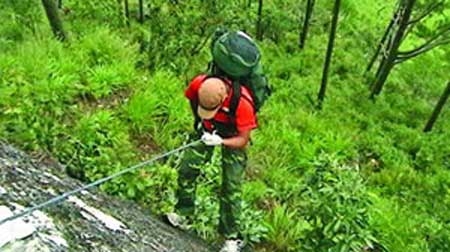The resort city of Da Lat is known as a paradise of flowers, fog and love, set at an altitude of 1,500m in the Central Highlands of Viet Nam.

Upward bound: Mountain climbing is popular with young visitors. — Photo tuoitreonline.com
The city is renowned for its love stories and one of the most popular is the tale of K'lang (a boy from the Lach ethnic group) and Ho-biang (a girl from the Chil group), Viet Nam's equivalent of Romeo and Juliet.
The area is known to local people as "the land of Langbiang", a combination of the star-crossed lovers' names.
A visit to the tourist attractions and the legends that surround the place touches the hearts of the more romantically inclined, but it's also a great place just to get away from the heat and fast pace of daily life.
Nui Voi or Elephant Mountain is a popular destination. The mountain is about 15km to the south of the city centre, and the 1,576m peak resembles two huge elephants lying in a green sky of water.
The Lach people say that K'lang used to have a special gift with animals, and when he was 14, he successfully tamed two wild elephants from a neighbouring region – La Ngu Ha.
The young couple's destiny was sealed on the day that K'lang rescued Biang from danger and they fell in love. The people, animals and plants were all very happy about the news, especially the two elephants, and waited expectantly for K'lang and Biang's wedding, but Biang was the daughter of a Chil chief, and he opposed the union.
Determined never to be separated, the couple decided that the only way they could be together forever was in death, so they sat together on a mountain until they passed away in each other's arms. Everyone was distraught, and the elephants were so grief-stricken that they died of broken hearts. Their bodies turned into what today is known as Elephant Mountain.
The mountain is located in Dinh An Commune, Duc Trong District in the Central Highland Province of Lam Dong. At the foot of the mountain is a tourist zone covering an area of over 100ha.
Director of the zone Nguyen Thuy Phuong Tram said that eco-tours and trekking were popular because they offered visitors a chance to explore nature.
She explained that when people get closer to nature and appreciate its beauty, they are more likely to cherish and protect it.
"That is the reason why Elephant Mountain is attracting more and more people," she said.
Besides accommodation and restaurants, there is also a centre where visitors can learn mountain climbing and other outdoor skills which are particularly popular with young people.
"They are also taught how to care for themselves, work within the community and utilise their skills, as well as the importance of relaxation," she said.
From the foot of the mountain, just take a stroll and follow a winding path that leads to Darahoa Village. There, visitor can learn about the native K'ho group, who are said to be the descendants of the Lang and Biang tribes.
After their deaths, Biang's father realised he had been wrong to oppose the marriage so he united all the hill tribes, and since the young men and women have happily inter-married.
Trekkers prefer to explore Elephant Mountain off road, walking through pine forests while taking in the picturesque landscape.
Further up the slopes, streams criss-cross the path and wild orchids add a burst of colour to the surroundings. To the south, thousand-year-old red pine trees tower over their younger cousins, something that cannot be seen anywhere else in the country.
As intrepid travellers approach the summit, a fresh water lake greets them and provides a welcome boost before they attempt to use the skills they learnt at the centre to take on a steep cliff.
With strong feet and nimble hands – and a bit of help from the guides – climbers conquer the mountain, possibly inspiring dreams of one day standing on top of the world.
For the less adventurous, there is an important guerrila base used during the wars against French and American forces. Today, the trenches are open for visitors.
After a long day on the mountain, guests can enjoy a dinner of local food grilled over an open fire. During winter when the chill of the mountain air closes in, the fire is built up and young K'ho boys and girls dance to the rhythm of traditional music, praying for peace and prosperity.